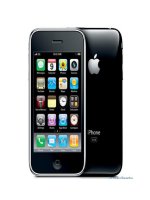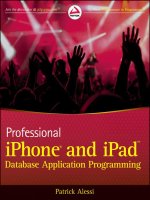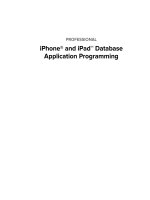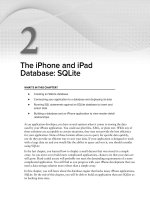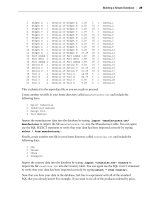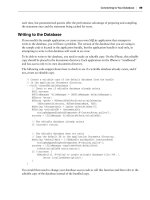Phát triển ứng dụng cho iPhone và iPad - part 16 pot
Bạn đang xem bản rút gọn của tài liệu. Xem và tải ngay bản đầy đủ của tài liệu tại đây (5.35 MB, 10 trang )
< ?xml version=”1.0” encoding=”UTF-8”? >
< !DOCTYPE plist PUBLIC “-//Apple//DTD PLIST 1.0//EN” “ /> PropertyList-1.0.dtd” >
< plist version=”1.0” >
< array >
< dict >
< key > address < /key >
< string > 123 Any St. < /string >
< key > age < /key >
< integer > 20 < /integer >
< key > firstName < /key >
< string > John < /string >
< key > lastName < /key >
< string > Smith < /string >
< key > phone < /key >
< string > 555-1234 < /string >
< /dict >
< dict >
< key > address < /key >
< string > 789 Town St. < /string >
< key > age < /key >
< integer > 40 < /integer >
< key > firstName < /key >
< string > Doris < /string >
< key > lastName < /key >
< string > Jones < /string >
< key > phone < /key >
< string > 555-1234 < /string >
< /dict >
< /array >
< /plist >
MOVING FORWARD
In this chapter, you learned how to use some of the features of the iPhone SDK that are specifi c to
the iPad. First, you explored using the
UISplitViewController to build master/detail displays.
Then, you learned how to display informational messages on top of another view using the
UIPopoverController . Next, you discovered how to use gesture recognizers to handle complex
user interactions. Finally, you found out how you can share data between the device and the
computer by using fi le - sharing support.
This concludes Part I, where you learned how to build a simple data - based application, how to get
data onto the device and store it using SQLite, and how to display data and customize the display of
data using the
UITableView .
In Part II, you will learn about the Core Data framework. Core Data is a powerful library that you
can use to create and manage data on the iPhone. Core Data comes with a powerful modeling tool
that you will use to help you defi ne the data model for your applications.
Moving Forward
❘
119
CH004.indd 119CH004.indd 119 9/18/10 9:30:43 AM9/18/10 9:30:43 AM
CH004.indd 120CH004.indd 120 9/18/10 9:30:43 AM9/18/10 9:30:43 AM
PART II
Managing Your Data
with Core Data
CHAPTER 5: Introducing Core Data
CHAPTER 6: Modeling Data in Xcode
CHAPTER 7: Building a Core Data Application
CHAPTER 8: Core Data–Related Cocoa Features
CHAPTER 9: Core Data Migration and Performance
CH005.indd 121CH005.indd 121 9/18/10 9:34:09 AM9/18/10 9:34:09 AM
CH005.indd 122CH005.indd 122 9/18/10 9:34:13 AM9/18/10 9:34:13 AM
Introducing Core Data
WHAT ’ S IN THIS CHAPTER?
Describing what the Core Data API can do for you
Understanding the various objects that make up the Core Data API
Understanding how the template code works to confi gure your
application to use Core Data
Creating a simple application that uses Core Data to maintain appli-
cation state
Now that you have completed the fi rst part of the book, you should be comfortable using an
SQLite database and implementing views into your data with the
UITableView control. You
have learned to build data - driven applications for the iPhone that can effi ciently access large
amounts of data stored in an SQLite database and display that data with your own, highly
customized, tables.
Up until this point, you have not looked at how to store the data that users create on the
device. For instance, if you wanted to create a task manager, you would need to be able to
save the user - created tasks. You could use SQLite to
INSERT the data, now that you know how
to execute arbitrary SQL statements against the database. However, there is an API designed
specifi cally for storing the objects in your application model: Core Data.
In this chapter, you learn about the architecture of the Core Data API and the classes that you
use to build a Core Data application. You will walk through a Core Data template application
to learn how to implement the architecture in code. Then you will learn how to build a simple
application that uses Core Data for storage.
This chapter prepares you for the next few chapters where you dive deeply into the Core Data
tools and API.
➤
➤
➤
➤
5
CH005.indd 123CH005.indd 123 9/18/10 9:34:13 AM9/18/10 9:34:13 AM
124
❘
CHAPTER 5 INTRODUCING CORE DATA
THE BASICS OF CORE DATA
Core Data is a set of APIs designed to simplify the persistence of data objects. Sometimes you will
hear people refer to Core Data as an object persistence framework or an object graph manager.
Core Data provides a framework for saving your model objects and retrieving them later. Core Data
also manages changes to your object model, provides undo support, and ensures the consistency of
relationships between your model objects. All of these features help to free you from having to write
the code to implement this functionality. In essence, Core Data simplifi es the creation of the Model
part of the Model - View - Controller architecture.
The foundation of the Core Data tool set is a code - based API used to manipulate your data objects
in code. However, the tool set also includes a graphical data modeler that you can use to defi ne
your model objects. The modeler allows you to defi ne your data objects, their attributes, and their
relationships with the other objects in your application. You can even specify constraints
and simple validation rules inside the graphical tool. You explore the data modeling tool and all
of its uses in the next chapter.
The graphical modeler simplifi es creation of the model in the same way that Interface Builder
simplifi es the creation of the view. Using Core Data and Interface Builder, you can quickly build the
Model and View components of the MVC architecture, leaving only the controller business logic left
to code. This can signifi cantly reduce the development time of your projects.
In addition to its ease of use, Core Data provides some important performance enhancements as
well. Core Data can use SQLite as its backing data store. This provides a Core Data with high
performance query engine. When compared to searching and sorting through fl at data fi les or
plists, Core Data is the clear choice for speed. Additionally, the API is able to conserve memory by
retrieving only the data that you need at any specifi c time. For example, if you have two related
entities, Core Data will not retrieve the child entities until you ask for them. This conserves
memory, which is a scarce resource on mobile devices. You learn more about this functionality,
called faulting , in the chapters to come.
Core Data provides many of the functions that you would expect to fi nd when dealing with data
objects. Specifi cally, you can fi lter your data using predicates with the
NSPredicate class, and sort
your data using the
NSSortDescriptor class. I touch on these classes here and get into much fi ner
detail in Chapter 6.
THE CORE DATA ARCHITECTURE
To understand how to use Core Data, it helps to have an understanding of the underlying
architecture. While you will not be accessing most of the objects contained in the API directly, you
will be much more profi cient if you understand how Core Data works.
The Core Data Stack
The design of Core Data is a stack structure, as shown in Figure 5 - 1. The key components are the
data store, the Persistent Store Coordinator, the Managed Object Model, and the Managed Object
Context. While I feel that it is important to understand what is going on behind the scenes, try not
CH005.indd 124CH005.indd 124 9/18/10 9:34:15 AM9/18/10 9:34:15 AM
to get confused by the terminology introduced in this section. It may seem overwhelming now, but
as you work through the template and the sample in this chapter, the details of how you use Core
Data should become clear.
Managed Object Model
Entity
Managed Object Context
Managed
Objects
Persistent Store
Coordinator
Data Store
FIGURE 5 - 1: The Core Data stack
The Data Store
The data store is the fi le or group of fi les that hold your data. This is the actual fi le written to the
disk when the save message is sent to Core Data. Typically, in a mobile application, only one data
store fi le is used. However, it is possible to use a group of fi les as the data store.
The data store can be a binary data fi le, an SQLite database, or an in - memory data fi le, depending
on the parameters used when creating the data store. You will see how to specify the storage type
for your data in the example at the end of the chapter.
As the developer, you will never directly access the data store. The Persistent Store Coordinator
abstracts away access to the data fi le. In addition, you do not need to concern yourself with the data
store implementation. Simply consider it a fi le that holds all of your data.
The Persistent Store Coordinator
This Persistent Store Coordinator acts as a mediator between the managed object context and
the data store. The coordinator takes requests for data from the context and forwards them to the
The Core Data Architecture
❘
125
CH005.indd 125CH005.indd 125 9/18/10 9:34:15 AM9/18/10 9:34:15 AM
126
❘
CHAPTER 5 INTRODUCING CORE DATA
appropriate data store. The coordinator also allows the context to access one or more data stores as
if they were one. Finally, the coordinator associates a data store with a Managed Object Model. The
Persistent Store Coordinator is an instance of the
NSPersistentStoreCoordinator class.
You need to be aware that the NSPersistentStoreCoordinator class is not
thread safe. Therefore, if you plan to access a data store simultaneously across
multiple threads, you have to either create a coordinator for each thread or lock
and unlock the single coordinator manually.
The Managed Object Model
The Managed Object Model represents the data model schema. In code, the Managed Object Model
is an instance of the
NSManagedObjectModel class.
The model consists of a set of entities that defi ne the data objects in your application. When
designing your model, you specify the data entities that your application will deal with. You can
specify attributes for these entities and defi ne the relationships between them.
You typically create the model graphically using the Xcode data - modeling tool although it is
possible to defi ne the model in code. You can think of the managed object model like the Entity -
Relationship diagram that you would create when designing a database.
The data model should defi ne each data object used in your application. The Persistent Store
Coordinator uses the model to create Managed Objects according to conventions from the entities
defi ned in the model. The coordinator also maps the entities in the model into the physical data
store fi le that Core Data writes to disk.
You will rarely access the object model through your code. If the need arises, you can use the
NSManagedObjectModel class. You access the Managed Objects created from the model entities
using the Managed Object Context.
The Managed Object Context
The Managed Object Context, also referred to as the context , provides the main interface that you
will use to access your managed data objects. The managed object context is an instance of the
NSManagedObjectContext class.
You use the context to hold all of your managed data objects. Your managed data objects are either
instances or subclasses of the
NSManagedObject class. The name Managed Object makes sense as
the Managed Object Context manages all of these objects.
You can think of the context as the sandbox that holds all of your application data. You can add
objects to the context, delete them, and modify them in memory. Then, when you are ready, you can
tell the context to commit its current state to disk. Behind the scenes, the context uses the Persistent
Store Coordinator to write your data out to the data store on disk. The context uses the object
model to ensure that your data is in a consistent state with respect to your defi ned relationships,
constraints, and validation rules before committing it to disk.
CH005.indd 126CH005.indd 126 9/18/10 9:34:16 AM9/18/10 9:34:16 AM
You make fetch requests against the context to fetch data from the data store back into the context.
You fetch data into Managed Objects that you use to manipulate and display your data. Fetch
requests are similar to SQL
SELECT statements. When creating a fetch request, you can provide a
predicate to fi lter your data such as the SQL
WHERE clause. You also provide a sort array that
functions like the SQL
ORDER BY clause.
SQLite and Core Data
In Chapter 2, you learned how to use SQLite as the database engine for your application. Now that
you have learned about Core Data, you may be wondering how the two are related.
SQLite is a library that provides a relational database implementation used on the iPhone. Core
Data can use SQLite as the on - disk data store to persist your data. Core Data can also use a
proprietary binary data fi le for the data store. However, I would not generally recommend this
because the binary format requires that your entire object graph be loaded into memory as opposed
to using the SQLite format, which allows parts of the object graph to be loaded as needed.
While you learned how to view and modify the schema and data in an SQLite database, you should
never attempt to manually modify the schema or data in a Core Data SQLite data store. Core Data
requires that the data in the database be stored in a specifi c way in order to function. You should feel
free to browse the schema and data if you care to, but you should never attempt to modify either.
USING CORE DATA: A SIMPLE TASK MANAGER
Now that you are familiar with the terminology and the Core Data API architecture, I am going to
walk through a simple example application so that you can get your feet wet with using Core Data.
You will fi rst take a look at everything that you get “ for free ” when you
start a new application and tell Xcode that you want to use Core Data as
the backing data store. Then, you will customize the template - generated
code to create an application to keep track of a very simple task list.
You may feel overwhelmed by all of the information that you learned in
the previous section. You should take two things away from the previous
section. First is that most, if not all, of your interaction with Core Data
in your code will be through the Managed Object Context and Managed
Objects. The other is that you will defi ne your data model graphically
using the tool provided in Xcode.
Creating the Project
The application that you are going to create is a simple task manager.
It will allow you to enter new tasks and remove completed tasks. When
you create a task, it will be time - stamped. The application will sort the
tasks based on the timestamp with the newest tasks at the top of the
list. Figure 5 - 2 shows the application in action.
FIGURE 5 - 2: The completed
Tasks application
Using Core Data: A Simple Task Manager
❘
127
CH005.indd 127CH005.indd 127 9/18/10 9:34:21 AM9/18/10 9:34:21 AM
128
❘
CHAPTER 5 INTRODUCING CORE DATA
To start the project, open Xcode and create a new Navigation - based Application from the new
project template. Make sure that you select the option to “ Use Core Data for storage ” in the new
project window. Call the new project “ Tasks. ”
After you have created the project, build and run it. You will see that you get quite a bit of
functionality from the template without adding any code at all.
If you click on the plus button in the upper - right corner, time - stamp entries get added to your
TableView . You can swipe across an entry and click the Delete button to delete individual
timestamps. You can also click the Edit button to go into editing mode where you can delete entries
by clicking the icon to the left of a timestamp and then clicking the Delete button.
If you click the Home button in the iPhone simulator and then click the icon on the home screen for
your Tasks application, you will see that any timestamps that you did not delete are still there. Your
application already includes the code required to persist your data.
Examining the Template Code
Before you get into modifying the code to create and display tasks, let ’ s take a walk through the
template code. This should provide you with some insight into how the application works along
with showing you how to implement the Core Data architecture in code. Keep in mind that all of
this code is auto - generated when you select the Navigation - based Application template and opt to
use Core Data for storage.
Two classes are created by the template:
RootViewController and AppDelegate . You create these
same classes in any typical Navigation - based application. Additionally, if you open the Resources
folder of your project, you will see a data model fi le that was also auto - generated called
Tasks
.xcdatamodel
. Let ’ s look at each of these fi les.
TasksAppDelegate
While you won ’ t be modifying any of the code in the app delegate, it is instructive to look at the
code. The code in the app delegate sets up the Core Data stack. Therefore, as you might imagine,
there is code to create a Persistent Store Coordinator, Managed Object Model, and Managed Object
Context.
The
persistentStoreCoordinator getter method returns the Persistent Store Coordinator for the
application. Here is the code:
- (NSPersistentStoreCoordinator *)persistentStoreCoordinator {
if (persistentStoreCoordinator != nil) {
return persistentStoreCoordinator;
}
NSURL *storeUrl = [NSURL fileURLWithPath:
[[self applicationDocumentsDirectory]
stringByAppendingPathComponent: @”Tasks.sqlite”]];
NSError *error = nil;
persistentStoreCoordinator = [[NSPersistentStoreCoordinator alloc]
CH005.indd 128CH005.indd 128 9/18/10 9:34:22 AM9/18/10 9:34:22 AM
